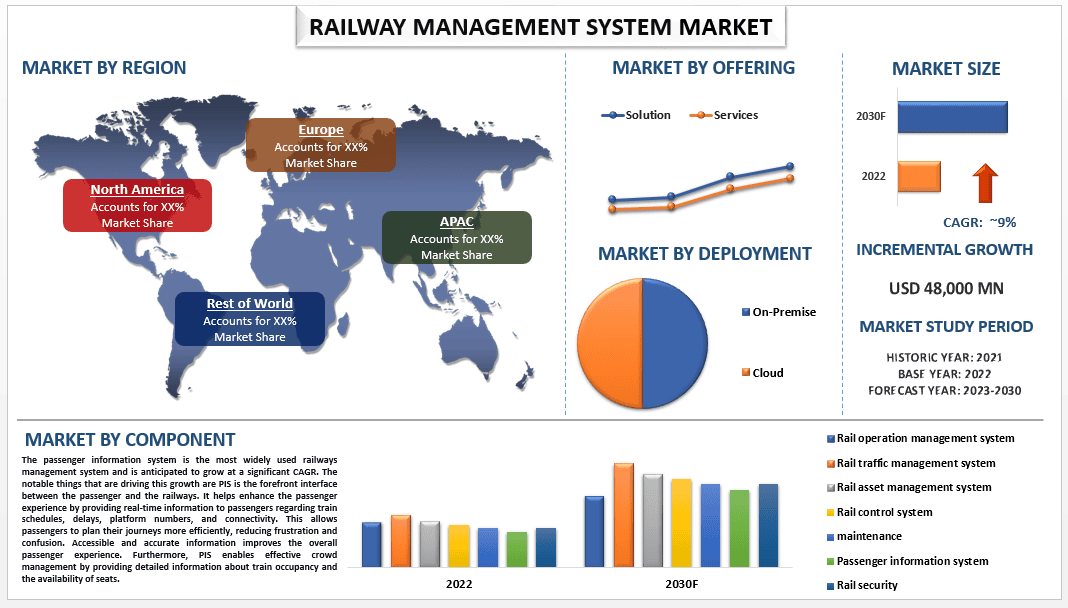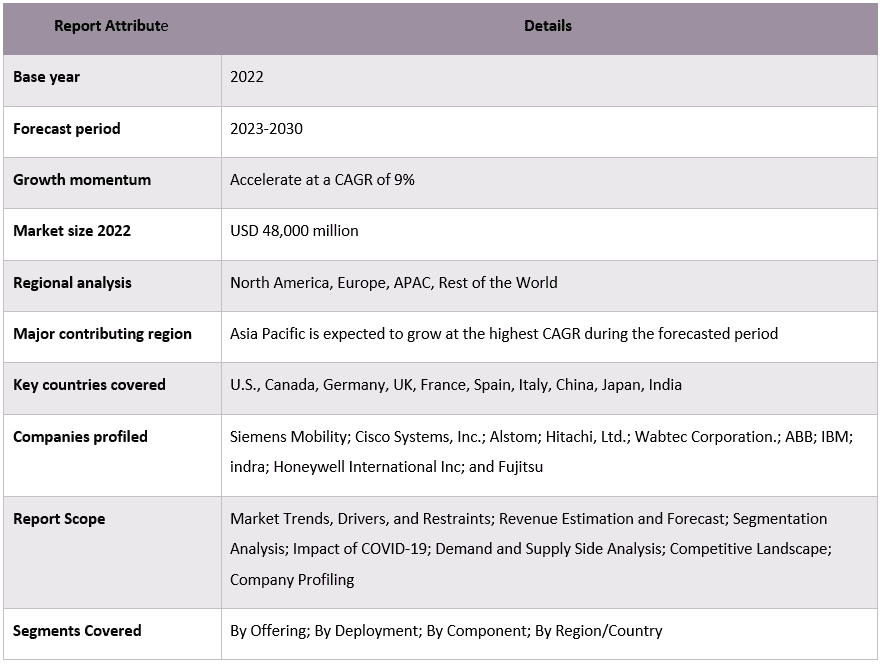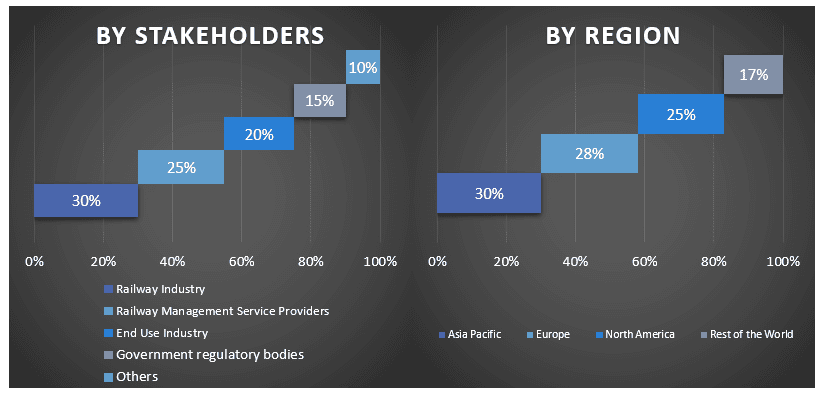- Home
- About Us
- Industry
- Services
- Reading
- Contact Us
Railway Management System Market: Current Analysis and Forecast (2023-2030)
Emphasis on Offerings (Solutions and Services), Deployment (On-premise and Cloud), Components (Rail Operation Management System, Rail Traffic Management System, Rail Asset Management System, Rail Control System, Rail Maintenance Management System, Passenger Information System, and Rail Security), Region/Country.

The railway management systems market is valued at USD 48 Billion in 2022 & is expected to grow at a CAGR of 9% from 2023-2030. A railway management system is a software-based solution designed to automate and streamline various processes involved in managing and operating a railway network. It helps railway authorities and operators efficiently manage train schedules, ticketing, reservations, track maintenance, inventory, passenger information, and other related activities. The system typically includes modules for train scheduling, ticketing, passenger information display, maintenance management, asset management, and reporting. It aims to improve railway services’ overall efficiency, safety, and quality by providing real-time data, automated processes, and decision-support tools for better management and decision-making. The demand for railway management systems is growing owing to the increasing railway infrastructure, rolling stock numbers, and rising number of commuters through this mode of transport.
Furthermore, rising development towards sustainability across the industry puts railways into the mainstream, where railways are amongst the most efficient and lowest emitting modes of transport and are electrified at large magnitude. For instance, in 2019, IEA (International Energy Agency) published a report according to which railways carry around 8% of the world’s passenger movements and about 7% of freight movement. Yet, it accounts for only 2% of the total energy used by the transport industry. Moreover, if all the operations currently carried out by railways are shifted toward road vehicles will lead to a 15% rise in total oil consumption and 1.2 Gigatonnes of additional GHG emissions.
Some of the major players operating in the market include Siemens Mobility; Cisco Systems, Inc.; Alstom; Hitachi, Ltd.; Wabtec Corporation.; ABB; IBM; indra; Honeywell International Inc; and Fujitsu.
Insights Presented in the Report
“Amongst offerings, the solutions and services both are anticipated to witness a significant CAGR growth during the forecast period.”
Based on offerings, the market is bifurcated into solutions and services. Both solutions and services are anticipated to witness a strong pace of growth as both are an integral part in order to keep the system operational and working in tandem. Where in solutions companies provide innovative and energy-efficient technologies to the rail sector, it’s manufacturing, and servicing of all components and subsystems in intercity, urban and high-speed networks for rail infrastructure and rolling stock. Furthermore, solutions such as electrification solutions, ventilation solutions, traction systems and products for rolling stocks, etc are also high in demand. Whereas, services such as IT and telecom services and facility management services are also very integral for operational efficiency, and connectivity, and for enhancing the overall convenience of the passengers, and hence play a primary role in keeping the system operational and reliable.
“Amongst component, the passenger information system is anticipated to grow at a strong CAGR in the market during the forecasted period.”
Based on components, the market is segmented into rail operation management system, rail traffic management system, rail asset management systems, rail control system, rail maintenance management system, passenger information system, and rail security. The passenger information system is the most widely used railways management system and is anticipated to grow at a significant CAGR. The notable things that are driving this growth are, PIS is the forefront interface between the passenger and the railways and helps enhance the passenger experience by providing real-time information to passengers regarding train schedules, delays, platform numbers, and connectivity. This helps passengers plan their journeys more efficiently, reducing frustration and confusion. Accessible and accurate information leads to an improved overall passenger experience. Furthermore, PIS enables effective crowd management by providing detailed information about train occupancy and the availability of seats. This helps railway operators optimize resources, distribute passengers evenly across trains, and reduce overcrowding. Additionally, PIS can also contribute to revenue generation by offering targeted advertising opportunities. With access to passenger data and preferences, railways can display relevant advertisements, promotions, or service offerings, allowing them to monetize their digital platforms effectively.
Railway Management System Market Report Coverage

“Asia Pacific dominated the railway management systems market in 2022.”
The Asia Pacific region holds the majority of the market share and is also poised to witness significant growth in the CAGR terms during the forecasted period. For instance, as of 2019 as per IEA (International Energy Agency), almost 90% of global passenger movements on conventional railways take place in these countries and regions, with India being the leader at 39%, followed by the People’s Republic of China (27%), Japan (11%) and the European Union (9%). Furthermore, these countries are also investing significantly in high-speed rail and metros with the highest investments being overtaken by China which has surpassed all other countries in terms of network length within a single decade timeframe. For instance, as of 2019 as per the IEA, China accounts for about two-thirds of high-speed rail activity having overtaken both Japan (17%) and the European Union (12%). Moreover, with the population on the rise this growth in population will not be evenly spread, and the majority of the increase will happen in major cities, posing a challenge as cities can’t continue to grow in geographic size forever, and larger more populous, and more dense cities along with increasing vehicle ownership, will pose a significant challenge for quick, convenient, and affordable transportation as congestions will increase. Furthermore, with growing GDP there will likely be a huge growth in freights as well. And to manage these challenges countries in these regions have to significantly increase their rail infrastructure, as its an efficient, environmentally, and socially beneficial mode of transport with lower emissions and safer to travel can help reduce congestion in the cities. Additionally, the answer to all these problems is high-speed rails which provide a high-quality substitute for short-distance flight travel and also are reliable, affordable, and fast alternatives to road travel as well as enable high-capacity goods movement over long distances. All these factors are aligning in the direction, which is building a perfect case for the next leg of growth in the railways industry which in turn will drive the growth of the railway management system during the forecasted period.
Reasons to buy this report:
- The study includes market sizing and forecasting analysis validated by authenticated key industry experts.
- The report presents a quick review of overall industry performance at one glance.
- The report covers an in-depth analysis of prominent industry peers with a primary focus on key business financials, product portfolios, expansion strategies, and recent developments.
- Detailed examination of drivers, restraints, key trends, and opportunities prevailing in the industry.
- The study comprehensively covers the market across different segments.
- Deep dive regional level analysis of the industry.
Customization Options:
The global railway management systems market can further be customized as per the requirement or any other market segment. Besides this, UMI understands that you may have your own business needs, hence feel free to connect with us to get a report that completely suits your requirements.
Table of Content
Research Methodology for the Railway Management System Market Analysis (2023-2030)
Analyzing the historical market, estimating the current market, and forecasting the future market of the global railway management systems market were the three major steps undertaken to create and analyze the adoption of railway management systems in major regions globally. Exhaustive secondary research was conducted to collect the historical market numbers and estimate the current market size. Secondly, to validate these insights, numerous findings and assumptions were taken into consideration. Moreover, exhaustive primary interviews were also conducted, with industry experts across the value chain of the global railway management systems market. Post assumption and validation of market numbers through primary interviews, we employed a top-down/bottom-up approach to forecasting the complete market size. Thereafter, market breakdown and data triangulation methods were adopted to estimate and analyze the market size of segments and sub-segments of the industry pertains to. Detailed methodology is explained below:
Analysis of Historical Market Size
Step 1: In-Depth Study of Secondary Sources:
Detail secondary study was conducted to obtain the historical market size of the railway management systems market through company internal sources such as annual reports & financial statements, performance presentations, press releases, etc., and external sources including journals, news & articles, government publications, competitor publications, sector reports, third-party database, and other credible publications.
Step 2: Market Segmentation:
After obtaining the historical market size of the railway management systems market, we conducted a detailed secondary analysis to gather historical market insights and share for different segments & sub-segments for major regions. Major segments are included in the report by offering, by deployment, and by component. Further country-level analyses were conducted to evaluate the overall adoption of testing models in that region.
Step 3: Factor Analysis:
After acquiring the historical market size of different segments and sub-segments, we conducted a detailed factor analysis to estimate the current market size of the railway management systems market. Further, we conducted factor analysis using dependent and independent variables such as offering, by deployment, and by component of the railway management systems market. A thorough analysis was conducted for demand and supply-side scenarios considering top partnerships, mergers and acquisitions, business expansion, and product launches in the railway management systems market sector across the globe.
Current Market Size Estimate & Forecast
Current Market Sizing: Based on actionable insights from the above 3 steps, we arrived at the current market size, key players in the global railway management systems market, and market shares of the segments. All the required percentage shares split and market breakdowns were determined using the above-mentioned secondary approach and were verified through primary interviews.
Estimation & Forecasting: For market estimation and forecast, weights were assigned to different factors including drivers & trends, restraints, and opportunities available for the stakeholders. After analyzing these factors, relevant forecasting techniques i.e., the top-down/bottom-up approach were applied to arrive at the market forecast for 2030 for different segments and sub-segments across the major markets globally. The research methodology adopted to estimate the market size encompasses:
- The industry’s market size, in terms of revenue (USD) and the adoption rate of the railway management systems market across the major markets domestically
- All percentage shares, splits, and breakdowns of market segments and sub-segments
- Key players in the global railway management systems market in terms of products offered. Also, the growth strategies adopted by these players to compete in the fast-growing market
Market Size and Share Validation
Primary Research: In-depth interviews were conducted with the Key Opinion Leaders (KOLs) including Top Level Executives (CXO/VPs, Sales Head, Marketing Head, Operational Head, Regional Head, Country Head, etc.) across major regions. Primary research findings were then summarized, and statistical analysis was performed to prove the stated hypothesis. Inputs from primary research were consolidated with secondary findings, hence turning information into actionable insights.
Split of Primary Participants in Different Regions

Market Engineering
The data triangulation technique was employed to complete the overall market estimation and to arrive at precise statistical numbers for each segment and sub-segment of the global railway management systems market. data was split into several segments & sub-segments post studying various parameters and trends in the areas of offering, by deployment, and by component in the global railway management systems market.
The main objective of the Global railway management systems Market Study
The current & future market trends of the global railway management systems market were pinpointed in the study. Investors can gain strategic insights to base their discretion for investments on the qualitative and quantitative analysis performed in the study. Current and future market trends determined the overall attractiveness of the market at a regional level, providing a platform for the industrial participant to exploit the untapped market to benefit from a first-mover advantage. Other quantitative goals of the studies include:
- Analyze the current and forecast market size of the railway management systems market in terms of value (USD). Also, analyze the current and forecast market size of different segments and sub-segments
- Segments in the study include areas of the offering, by deployment, and by component.
- Define and analysis of the regulatory framework for the railway management systems industry
- Analyze the value chain involved with the presence of various intermediaries, along with analyzing customer and competitor behaviors of the industry
- Analyze the current and forecast market size of the railway management systems market for the major region
- Major countries of regions studied in the report include Asia Pacific, Europe, North America, and the Rest of the World
- Company profiles of the railway management systems market and the growth strategies adopted by the market players to sustain in the fast-growing market
- Deep dive regional level analysis of the industry
Related Reports
Customers who bought this item also bought










